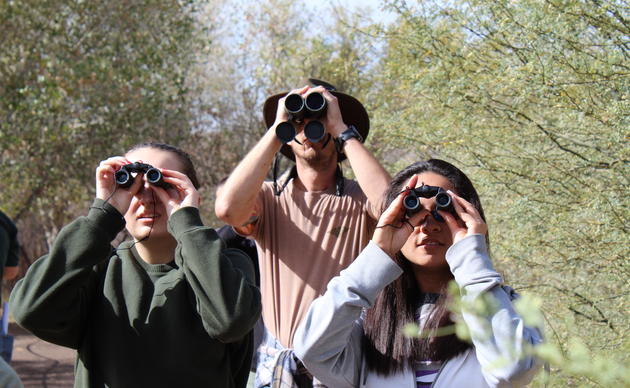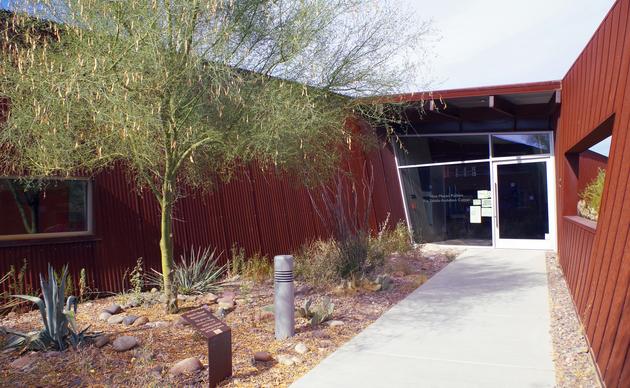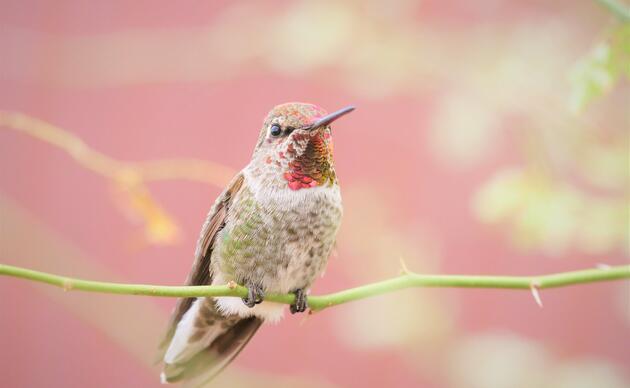Identifying the Birds in Your Backyard.
Many people enjoy watching the birds in their back yard but have no idea how to go about identifying them. Opening a field guide will give you somewhere around 900 birds to choose from and the task can seem too daunting. So here are a few tips to help you get started.
Let’s start with the size of a bird. Find something in your yard that you can measure; a plant plot, rock, maybe even a bird feeder. Once you know the size of that object you can judge the size of a bird in comparison. Field guides generally give the size of a bird from bill tip to tail tip.
Next look at the shape of your bird, does your bird have a fat body and short tail or is it slim with a long tail? Are the legs long or short, are the wings neatly folded against the body or do they project beyond?
Have a look at the bill of your bird. Bills are adapted to the type of food the birds prefer. Finches have bills made for cracking open seeds; Verdins have sharp tweezer shaped bills for seizing insects from trees and plants. Hummingbirds have long probing beaks that they use to find nectar in tubular shaped flowers but they can also catch insects in flight. Woodpeckers have bills shaped like chisels – obviously they can use these to get into cacti and trees for food and to make a home.
How does your bird behave? Is it always on the ground with other birds of the same size and appearance? Can it feed from your bird feeder by hanging on or does it have to wait underneath for what other birds drop? Does your bird prefer to fly from place to place or does it hop or walk? Does it prefer to perch on trees and bushes or does it like to investigate the undergrowth.
Is your bird solitary, coming to your yard by itself or is your bird gregarious, always turning up with other birds who look the same? If it comes with other birds is it a large number of birds, ten to twenty at a time or is it a small family group of two to five?
Then of course there is plumage and color. Always look for a pattern in the plumage and you will, of course, notice color. A word of warning though, color can be deceptive. Diet, health, age, sex and season can all have an affect on color.
Lastly – try to notice the sounds the bird makes. Birds have calls which they use to communicate everyday messages, like “I’ve got food,” or “Look out danger.”
They also have songs which they use to defend territory or attract mates.
Where to get help
For more help online try using this link to the ASU “Ask a Biologist” site. Here you will not only find images and descriptions of birds but also recordings of their calls. The site also has a wonderful “bird finder” which helps you identify what you see.
Experiment with Field Guides – you can get them out of your library and see what you like best. If you live in the Phoenix area, Audubon Arizona has an excellent small guide to the Birds of Phoenix which is a great starting point for beginning birders.
Try a Bird Walk or a Beginning Birding Class. The Rio Salado center offers free bird walks and beginning birding classes– see our events calendar for details.
If you can’t get to the Center or you live in another part of Arizona check out your local Audubon Chapter who likely have their own Bird Walks and classes.
Of course you don’t have to know the name to appreciate the beauty of a bird. Once you can identify a bird, however, you are able to find out so much more information and suddenly you have opened the door to a fascinating world that will intrigue you for a life time.
How you can help, right now
Donate to Audubon Southwest
Donate to save birds and educate the conservation leaders of tomorrow.
Join us for free guided bird walks
Free guided bird walks - Every first and third Saturday from 8 a.m. to 9 a.m. Please meet inside the center 5-10 minutes before departure time. Read more details here.
Sign up to volunteer with us!
Help restore environments or build habitat for displaced Burrowing Owls. Click here for more information.




